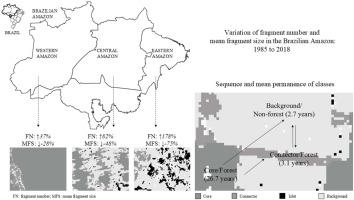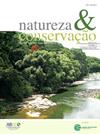Forest fragmentation in the Brazilian Amazon: Trends and conservation strategies
IF 3.5
2区 环境科学与生态学
Q1 BIODIVERSITY CONSERVATION
引用次数: 0
Abstract
Tropical forests have experienced increasing fragmentation. The trajectory of forest fragmentation (sequence, permanence, and location) offers valuable insights for shaping environmental strategies. We examined fragmentation trends and metrics in the Brazilian Amazon over a 34-year period, encompassing its macroregions: Western (WA), Central (CA), and Eastern Amazon (EA). The findings reveal an ongoing fragmentation, characterized by an increase in fragment numbers (WA: +37%, from 49,871 to 68,067 fragments; CA: +82%, 72,463–132,051 fragments; EA: +178%, 164,249–456,399 fragments) and a reduction in mean fragment size (WA: −28%, from 2825.7–2036.8 ha; CA: −48%, 1747.4–905.4 ha; EA: −75%, 651.8–162.3 ha), particularly in the east. Transitions occurred across few forest classes, typically, from forest Core to connecting forest, and eventually to anthropogenic areas. The Core class's permanence was longest in WA (32 years), while anthropogenic areas had the highest permanence in EA (7.6 years) and the lowest in WA (<1 year). Intermediate fragmentation classes were more prevalent in EA, which also demonstrated higher entropy. CA requires immediate attention actions from decision-makers to prevent the intense fragmentation shown in EA. We suggested strategies to mitigate Amazon fragmentation, emphasizing integrated metrics and region-specific approaches for enhanced connectivity and reduced forest loss.

巴西亚马逊森林破碎化:趋势和保护策略
热带森林日益破碎化。森林破碎化的轨迹(序列、持久性和位置)为制定环境战略提供了有价值的见解。我们研究了34年来巴西亚马逊地区的碎片化趋势和指标,包括其宏观区域:西部(WA)、中部(CA)和东部亚马逊(EA)。研究结果显示了持续的碎片化,其特征是片段数量增加(WA: +37%,从49,871个片段增加到68,067个片段;CA: +82%, 72,463-132,051个片段;EA: +178%, 164,249-456,399个片段),平均片段大小减少(WA: - 28%,从2825.7-2036.8 ha;CA:−48%,1747.4-905.4 ha;EA:−75%,651.8-162.3 ha),特别是在东部。过渡发生在少数森林类别之间,通常是从森林核心到连接森林,并最终到人为区域。核心类在西澳的持续时间最长(32年),人为区在东澳的持续时间最长(7.6年),西澳的持续时间最短(1年)。中间碎片类在EA中更为普遍,也表现出更高的熵。CA需要决策者立即采取行动,以防止EA中显示的强烈碎片化。我们提出了减轻亚马逊碎片化的策略,强调综合指标和区域特定方法,以增强连通性和减少森林损失。
本文章由计算机程序翻译,如有差异,请以英文原文为准。
求助全文
约1分钟内获得全文
求助全文
来源期刊

Perspectives in Ecology and Conservation
Environmental Science-Nature and Landscape Conservation
CiteScore
7.80
自引率
4.30%
发文量
46
审稿时长
59 days
期刊介绍:
Perspectives in Ecology and Conservation (PECON) is a scientific journal devoted to improving theoretical and conceptual aspects of conservation science. It has the main purpose of communicating new research and advances to different actors of society, including researchers, conservationists, practitioners, and policymakers. Perspectives in Ecology and Conservation publishes original papers on biodiversity conservation and restoration, on the main drivers affecting native ecosystems, and on nature’s benefits to people and human wellbeing. This scope includes studies on biodiversity patterns, the effects of habitat loss, fragmentation, biological invasion and climate change on biodiversity, conservation genetics, spatial conservation planning, ecosystem management, ecosystem services, sustainability and resilience of socio-ecological systems, conservation policy, among others.
 求助内容:
求助内容: 应助结果提醒方式:
应助结果提醒方式:


